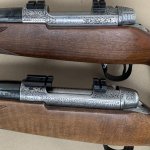That depends on what aspects of a rifle you value. The alloy floorplates are generally functional (although definitely not as sturdy as steel), light, and have no effect on accuracy as you note, but are soft and easily scratched. My main complaint (and that of many others) is aesthetic. Once the rifle has had some real use, the scratches show up, the coating chips, and the gun ends up looking pretty bad. That bothers many. Much of the criticism arises from the recognition that Husqvarna could have made the bottom-metal unit of steel (as they did on their early small-ring Mauser actions), but chose not to mainly to cut costs. To many that aspect of the rifle is seen as tacky. Functionality and accuracy are important to be sure, but for many, aesthetics are important too. Just one more point: in fact broken floorplates and particularly, trigger guards have occurred on some of the alloy bottom-metal Husqvarnas. As an aside, I'd be cautious about characterizing others' opinions as "pointless." What is pointless to you may be important to others. You don't care that the bottom metal is alloy; others do. It's as simple as that!Repeatedly, I read complaints about an allot floorplate on the 1900 actions....
Really? Is that that only complaint, and frankly: is it even justifiable?
Never have they known to fail, warp, rust or pit. Chip yes...however that never effected accuracy or functionality what so eveeeeeer....!
Consider all of the plastic parts used on $1K++ rifles these days, I'm find it disturbing that a well made, a well fitted alloy floor plate on such an amazing and accurate action, is such a point (more accurately - pointless) area of contention.....imho...
Last edited:













































































